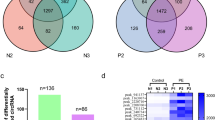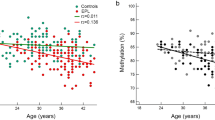Abstract
Preeclampsia (PE) is a major obstetrical complication that results in maternal and fetal morbidity and mortality. Aberrant epigenetic modifications are widely involved in the pathogenesis of PE. Previously, the activated leukocyte cell adhesion molecule (ALCAM) was reported to be required for blastocyst implantation but has not been described in the context of pathological pregnancy. This study explored the expression of ALCAM and its methylation levels in the placentas and peripheral venous blood of patients with PE from a Chinese Han population. The mRNA and protein expression levels of ALCAM were downregulated in the PE placentas compared with the control placentas (P < 0.05). The methylation rate of the ALCAM gene promoter was considerably elevated in the placentas (P = 0.003, odds ratio (OR) = 0.264, 95% confidence interval (95% CI) [0.108–0.647], cases n = 47, controls n = 53) and peripheral blood (P = 0.007, OR = 0.455, 95% CI [0.256–0.806], cases n = 100, controls n = 100) of the PE patients compared with those of the normotensive women, suggesting a negative relationship between ALCAM methylation and gene transcription. Moreover, the transcriptional expression of ALCAM was dramatically increased by demethylating treatment in trophoblastic cells. ALCAM is expected to be involved in the pathogenesis of PE through methylation regulation.
This is a preview of subscription content, access via your institution
Access options
Subscribe to this journal
Receive 12 print issues and online access
$259.00 per year
only $21.58 per issue
Buy this article
- Purchase on Springer Link
- Instant access to full article PDF
Prices may be subject to local taxes which are calculated during checkout





Similar content being viewed by others
References
Mol B, Roberts C, Thangaratinam S, Magee L, de Groot C, Hofmeyr G. Pre-eclampsia. Lancet. 2016;387:999–1011.
Nevalainen J, Skarp S, Savolainen E, Ryynänen M, Järvenpää J. Intrauterine growth restriction and placental gene expression in severe preeclampsia, comparing early-onset and late-onset forms. J Perinat Med. 2017;45:869–77.
Pennington KA, Schlitt JM, Jackson DL, Schulz LC, Schust DJ. Preeclampsia: multiple approaches for a multifactorial disease. Dis Model Mech. 2012;5:9–18.
Jannie KM, Stipp CS, Weiner JA. ALCAM regulates motility, invasiveness, and adherens junction formation in uveal melanoma cells. PLoS ONE. 2012;7:e39330.
Devis L, Moiola CP, Masia N, Martinez-Garcia E, Santacana M, Stirbat TV, et al. Activated leukocyte cell adhesion molecule (ALCAM) is a marker of recurrence and promotes cell migration, invasion, and metastasis in early-stage endometrioid endometrial cancer. J Pathol. 2017;241:475–87.
Haouzi D, Dechaud H, Assou S, Monzo C, de Vos J, Hamamah S. Transcriptome analysis reveals dialogues between human trophectoderm and endometrial cells during the implantation period. Hum Reprod. (Oxford, England). 2011;26:1440–9.
Lian IA, Toft JH, Olsen GD, Langaas M, Bjorge L, Eide IP, et al. Matrix metalloproteinase 1 in pre-eclampsia and fetal growth restriction: reduced gene expression in decidual tissue and protein expression in extravillous trophoblasts. Placenta. 2010;31:615–20.
Panagodage S, Yong HE, Da Silva Costa F, Borg AJ, Kalionis B, Brennecke SP, et al. Low-dose acetylsalicylic acid treatment modulates the production of cytokines and improves trophoblast function in an in vitro model of early-onset preeclampsia. Am J Pathol. 2016;186:3217–24.
Ge J, Wang J, Zhang F, Diao B, Song ZF, Shan LL, et al. Correlation between MTHFR gene methylation and pre-eclampsia, and its clinical significance. Genet Mol Res. 2015;14:8021–8.
Chu T, Bunce K, Shaw P, Shridhar V, Althouse A, Hubel C, et al. Comprehensive analysis of preeclampsia-associated DNA methylation in the placenta. PLoS ONE. 2014;9:e107318.
Anderson CM, Ralph JL, Wright ML, Linggi B, Ohm JE. DNA methylation as a biomarker for preeclampsia. Biol Res Nurs. 2014;16:409–20.
Anton L, Brown AG, Bartolomei MS, Elovitz MA. Differential methylation of genes associated with cell adhesion in preeclamptic placentas. PLoS ONE. 2014;9:e100148.
Xuan J, Jing Z, Yuanfang Z, Xiaoju H, Pei L, Guiyin J, et al. Comprehensive analysis of DNA methylation and gene expression of placental tissue in preeclampsia patients. Hypertens Pregnancy. 2016;35:129–38.
Yeung KR, Chiu CL, Pidsley R, Makris A, Hennessy A, Lind JM. DNA methylation profiles in preeclampsia and healthy control placentas. Am J Physiol Heart Circ Physiol. 2016;310:H1295–303.
Piletič K, Kunej T. MicroRNA epigenetic signatures in human disease. Arch Toxicol. 2016;90:2405–19.
Robinson WP, Price EM. The human placental methylome. Cold Spring Harb Perspect Med. 2015;5:a023044.
Ching T, Song MA, Tiirikainen M, Molnar J, Berry M, Towner D, et al. Genome-wide hypermethylation coupled with promoter hypomethylation in the chorioamniotic membranes of early onset pre-eclampsia. Mol Hum Reprod. 2014;20:885–904.
Rahat B, Najar R, Hamid A, Bagga R, Kaur J. The role of aberrant methylation of trophoblastic stem cell origin in the pathogenesis and diagnosis of placental disorders. Prenat Diagn. 2017;37:133–43.
Novakovic B, Evain-Brion D, Murthi P, Fournier T, Saffery R. Variable DAXX gene methylation is a common feature of placental trophoblast differentiation, preeclampsia, and response to hypoxia. FASEB J. 2017;31:2380–92.
Lowe SA, Bowyer L, Lust K, McMahon LP, Morton M, North RA, et al. SOMANZ guidelines for the management of hypertensive disorders of pregnancy 2014. Aust N Z J Obstet Gynaecol. 2015;55:e1–29.
Grotegut C. Prevention of preeclampsia. J Clin Invest. 2016;126:4396–8.
Jia Y, Li T, Huang X, Xu X, Zhou X, Jia L, et al. Dysregulated DNA methyltransferase 3A upregulates IGFBP5 to suppress trophoblast cell migration and invasion in preeclampsia. Hypertension. 2017;69:356–66.
Martin E, Ray P, Smeester L, Grace M, Boggess K, Fry R. Epigenetics and preeclampsia: defining functional epimutations in the preeclamptic placenta related to the TGF-β pathway. PLoS ONE. 2015;10:e0141294.
Brew O, Sullivan MH, Woodman A. Comparison of normal and pre-eclamptic placental gene expression: a systematic review with meta-analysis. PLoS ONE. 2016;11:e0161504.
Fujiwara K, Ohuchida K, Sada M, Horioka K, Ulrich CD 3rd, Shindo K, et al. CD166/ALCAM expression is characteristic of tumorigenicity and invasive and migratory activities of pancreatic cancer cells. PLoS ONE. 2014;9:e107247.
Jeong YJ, Oh HK, Park SH, Bong JG. Prognostic significance of activated leukocyte cell adhesion molecule (ALCAM) in association with promoter methylation of the ALCAM gene in breast cancer. Molecules. 2018;23:131.
Lu XY, Chen D, Gu XY, Ding J, Zhao YJ, Zhao Q, et al. Predicting value of ALCAM as a target gene of microRNA-483-5p in patients with early recurrence in hepatocellular carcinoma. Front Pharm. 2017;8:973.
Smith NR, Davies PS, Levin TG, Gallagher AC, Keene DR, Sengupta SK, et al. Cell adhesion molecule CD166/ALCAM functions within the crypt to orchestrate murine intestinal stem cell homeostasis. Cell Mol Gastroenterol Hepatol. 2017;3:389–409.
Fujiwara H, Tatsumi K, Kosaka K, Sato Y, Higuchi T, Yoshioka S, et al. Human blastocysts and endometrial epithelial cells express activated leukocyte cell adhesion molecule (ALCAM/CD166). J Clin Endocrinol Metab. 2003;88:3437–43.
Abumaree MH, Al Jumah MA, Kalionis B, Jawdat D, Al Khaldi A, AlTalabani AA, et al. Phenotypic and functional characterization of mesenchymal stem cells from chorionic villi of human term placenta. Stem cell reviews. 2013;9:16–31.
Rezaei M, Eskandari F, Mohammadpour-Gharehbagh A, Harati-Sadegh M, Teimoori B, Salimi S. Hypomethylation of the miRNA-34a gene promoter is associated with Severe Preeclampsia. Clin Exp Hypertens. 2018;41:1–5.
Blair JD, Yuen RK, Lim BK, McFadden DE, von Dadelszen P, Robinson WP. Widespread DNA hypomethylation at gene enhancer regions in placentas associated with early-onset pre-eclampsia. Molecular human reproduction. 2013;19:697–708.
Orhant L, Rondeau S, Vasson A, Anselem O, Goffinet F, Allach El Khattabi L, et al. Droplet digital PCR, a new approach to analyze fetal DNA from maternal blood: application to the determination of fetal RHD genotype. Ann Biol Clin. 2016;74:269–77.
Shea J, Diamandis E, Hoffman B, Lo Y, Canick J, van den Boom D. A new era in prenatal diagnosis: the use of cell-free fetal DNA in maternal circulation for detection of chromosomal aneuploidies. Clin Chem. 2013;59:1151–9.
Funding
This research was supported by funding from the National Science Foundation of the P.R. China (No. 81600211); the Science Foundation of Shandong Province (ZR2016HM28 and ZR2014HP017); and by the Application and Basic Research Project of Qingdao (18-2-2-27-jch).
Author information
Authors and Affiliations
Contributions
Conceptualization, LZ and SL; Data curation, LZ and SL; Formal analysis, JL; Funding acquisition, LZ and SL; Investigation, ZY and WS; Methodology, QT and LZ; Project administration, LZ and SL; Resources, SL; Software, LW and YP; Supervision, ZY, WS, YG, QT and JL; Validation, LW, YP and YG; Writing—original draft, LW and YP; Writing—review and editing, LZ and SL.
Corresponding authors
Ethics declarations
Conflict of interest
The authors declare that they have no conflict of interest.
Additional information
Publisher’s note Springer Nature remains neutral with regard to jurisdictional claims in published maps and institutional affiliations.
Rights and permissions
About this article
Cite this article
Wei, Ll., Pan, Ys., Tang, Q. et al. Decreased ALCAM expression and promoter hypermethylation is associated with preeclampsia. Hypertens Res 43, 13–22 (2020). https://doi.org/10.1038/s41440-019-0337-0
Received:
Revised:
Accepted:
Published:
Issue Date:
DOI: https://doi.org/10.1038/s41440-019-0337-0



